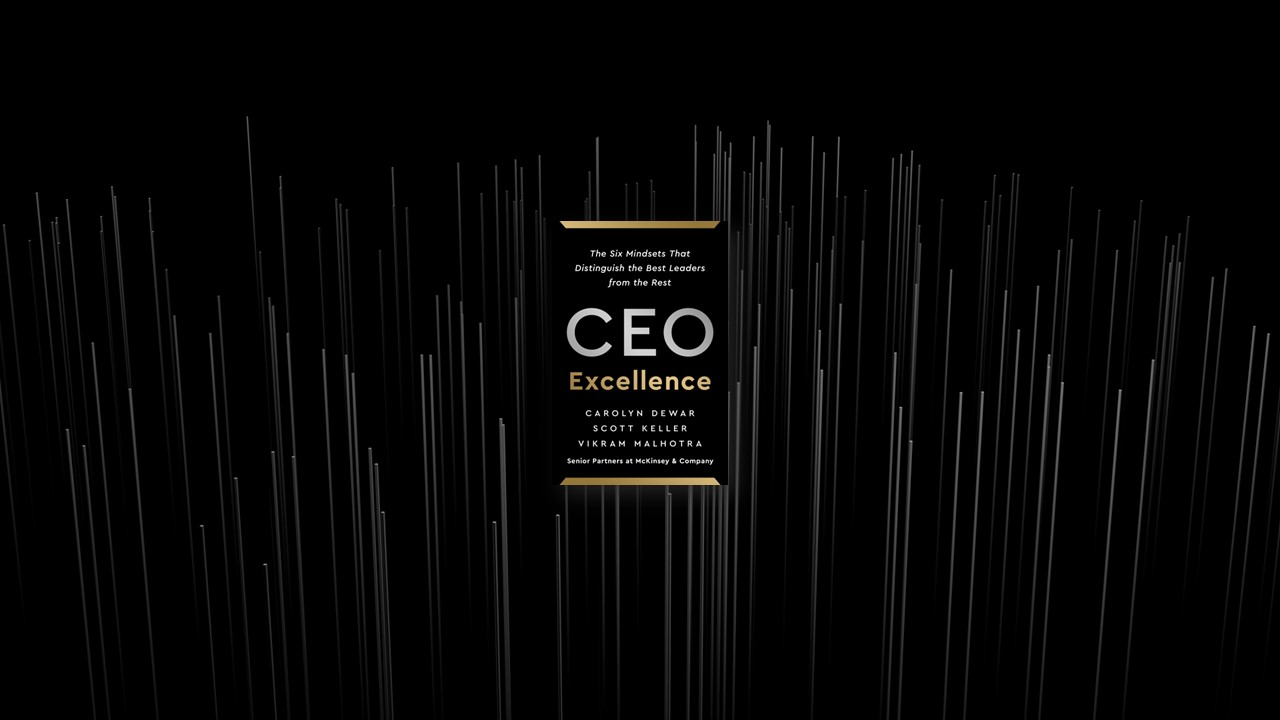Direction-Setting Mindset: Be Bold
In today’s complex world, many CEOs try to minimize uncertainty and guard against making mistakes. It sounds sensible. After all, the old adage that “discretion is the better part of valor” would seem to make sense for a job that has such a huge impact on a company’s stakeholders. Ultimately, however, such a cautious mindset has proven to deliver results that follow the dreaded “hockey stick” effect, consisting of a dip in next year’s budget followed by the promise of success, which never occurs.
The best CEOs recognize this dynamic and, in turn, approach setting the direction of their company with a different mindset. They embrace uncertainty with a view that fortune favors the bold. They’re less a “taker” of their fate and more a “shaper”—constantly looking for and acting on opportunities that bend the curve of history. CEOs who embrace this mindset are well aware that only 10 percent of companies create 90 percent of the total economic profit (profit after subtracting the cost of capital) and that the top quintile performers deliver thirty times more economic profit than the companies in the next three quintiles combined. And here’s the kicker: The odds of moving from being an average performer to a top-quintile performer over a ten-year period are only one in twelve.
Organization Alignment Mindset: Treat the Soft Stuff as the Hard Stuff
Once a CEO sets a direction for the company’s future, the probability that the plan will become reality is low. Many studies, including our own research, conclude that only one in three strategies is successfully implemented. The reasons for failure are rooted in the reality that change is rarely an intellectual problem, it’s an emotional one. The “soft stuff”—issues related to people and culture—account for the vast majority (72 percent) of the barriers to success.
This finding is hardly revelatory. It’s precisely what management guru Peter Drucker was referring to over fifty years ago when he purportedly said, “Culture eats strategy for breakfast.” Most CEOs understand this and readily acknowledge that the soft stuff is hard to get right. Accordingly, they ask their chief human resources officer (CHRO) to ensure there’s a good plan in place to handle the organization and talent-related changes needed to execute the strategy. These CEOs, however, generally don’t expect the same level of robustness and coherence in people-related plans as, for example, the CFO might provide in laying out a financial plan—after all, this is the soft stuff.
The best CEOs don’t follow this pattern. They don’t just acknowledge that the soft stuff is hard, they vow to treat the soft stuff as the hard stuff. And they make sure that every senior leader, not just the CHRO, owns the people-related implications of the strategy. KBC’s Johan Thijs puts it thusly: “You have to fix both sides as the CEO: The easy part is technical; the difficult part is people. You might fix the technical issues: finding capital, liquidity, profitability, and so forth. But over time if you can’t solve the mindset issues, you’ll go back on the same route because the mindset is going to drive you again over a cliff.”
Mobilizing Leaders Mindset: Solve for the Team’s Psychology
The dynamics of a top executive team can make or break a company. Investors know this—it’s why they cite the quality of the top management team as the single most important nonfinancial factor in evaluating a new IPO (initial public offering, in which a private company sells its shares to the public). Their instinct is backed by the data: When a top team works together with a common vision, a company is twice as likely to have above-median financial performance. As leadership expert John Maxwell once said, “Teamwork makes the dream work, but vision becomes a nightmare when the leader has a big dream and a bad team.”
The best CEOs recognize this challenge and acknowledge that it’s their leadership that will determine whether their team’s work will live up to its potential and propel the company forward. When thinking about how to get the most out of their leaders, many CEOs start with questions such as, “How often should we meet?” and “What should be on the agenda?” The best, however, think less about what the team does together, and more about how the team works together. They obsess with solving for the team’s psychology and let the mechanics of coordination and execution follow.
This focus on how the team works together versus what it does together brings to the fore such factors as composition, effectiveness, and operating rhythm. While this section mainly deals with the top team in big corporations, the lessons learned here apply to teams of any size, in any kind of organization.
Board Engagement Mindset: Help Directors Help the Business
Engaging with the board is one of the most daunting challenges that CEOs face. Why? Directors are at the pinnacle of governance—the CEO’s boss. That said, the board is like no boss an executive has ever had. As Ecolab’s Doug Baker explains: “Our synapses are designed for one boss. Our whole career, we have had one boss. And now all of a sudden, you’ve got thirteen versions of a boss.” GE’s Larry Culp adds, “Oh, and by the way, they don’t come to work every day, like all your other bosses did.”
To further complicate matters, it’s not the CEO’s role to determine who is on their board and how it operates. When Intuit’s Brad Smith asked one of his mentors, A. G. Lafley, a former CEO of Procter & Gamble, for advice on how to manage the board, the response was unambiguous: “Young man, first of all, you don’t manage the board. They manage you.” Even when a CEO also holds the board chair title, as is the case in almost half of the S&P 500, there is almost always a lead independent director appointed who is then responsible for most board matters. In short, the job of the board chair (or lead independent director) is to run the board and the job of the CEO is to run the organization.
Left to their own devices, however, boards rarely add great value to the organizations they govern. Only 30 percent of board members report that they serve on boards whose processes are effective, and early half of executives observe that their board’s performance falls short.
The best CEOs don’t tolerate these outcomes. Instead, they eschew the traditional mindset of “my role is to help the board fulfill its fiduciary duties” in favor of a mindset of “my role is to help directors help the business.”
Stakeholder Connection Mindset: Start with “Why?”
While it’s hard enough running a business and managing a board, today’s CEOs find that they must interact with stakeholder groups more often than they ever could have imagined. As Microsoft’s Satya Nadella puts it: “The job is all about customers; it’s all about partners; it’s all about your employees, your investors, governments. It’s all about all of them, all the time.” In fact, how well a business performs can be linked to how well a CEO handles such interactions. Research shows that a company’s relationships with external stakeholders can influence as much as 30 percent of corporate earnings.
Most CEOs understand this reality, and in turn ask their public relations departments to help them maintain good relationships with stakeholders. The focus is predominately on who to talk to, about what, and when. The best CEOs, however, start with the question of “why?”: Why is our company worthy of operating in society? Why are we relevant to each of our stakeholders? Why are each of our stakeholders relevant to us? Why are they choosing to do whatever they might be doing? By deeply understanding the motivations, hopes, and fears of their constituents, excellent CEOs create strong bonds with the outside world that help the business prosper in the long run.
Personal Effectiveness Mindset: Do What Only You Can Do
The various CEO responsibilities often require a soul-crushing schedule. To meet this challenge, the best make sure they’re both psychologically and physically fit—no easy task. As Majid Al Futtaim’s Alain Bejjani puts it, “Leading yourself is the most difficult and the most daunting task. It requires the most courage.”
Daunting is right—so much so that not every CEO we spoke to felt they could give advice on the topic. As one CEO said to us, “I felt like I was walking through land mines every day. I didn’t thrive, I just didn’t get blown up. It’s a lot of work.” Having said that, they also recognized that—more than with any of the other areas—managing personal effectiveness was under their control. As Mastercard’s Ajay Banga pointed out, “If you, as the CEO, can’t figure out what matters to you, and if you’re not willing to make the time for it, then it’s your problem. Nobody can help you.” In fact, this topic was seen as so essential and difficult that many of the CEOs we spoke to suggested it should be the first chapter of any discussion about the job. We’ve left it to the end only because we felt it was important to first deeply understand the assortment of responsibilities placing demands on a CEO’s energy. After all, almost 50 percent of chief executives say that the role is “not what I expected beforehand.”
The choices the best CEOs make to manage their personal well-being and effectiveness are precisely that—personal. There are, however, some commonalities. In the words of Galderma’s Flemming Ørnskov: “People are successful operating in very different ways. But if I look at the CEOs I admire and know well, I think they all display discipline.” Ørnskov’s observation raises the question: Discipline around what? Many CEOs answer that question with: “My job is to do what needs to be done.” That isn’t how the best CEOs think, however. Rather, their mindset is: “My job is to do what only I can do.” Caterpillar’s Jim Owens explains that the key to personal effectiveness is: “Prioritizing the most critical issues that only the CEO can solve and delegating any remaining tasks.”


